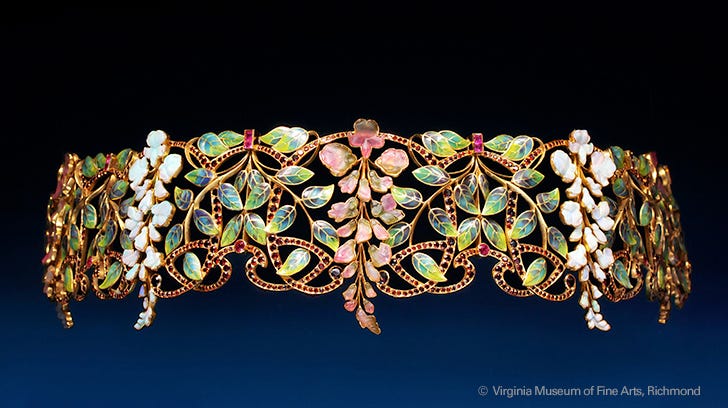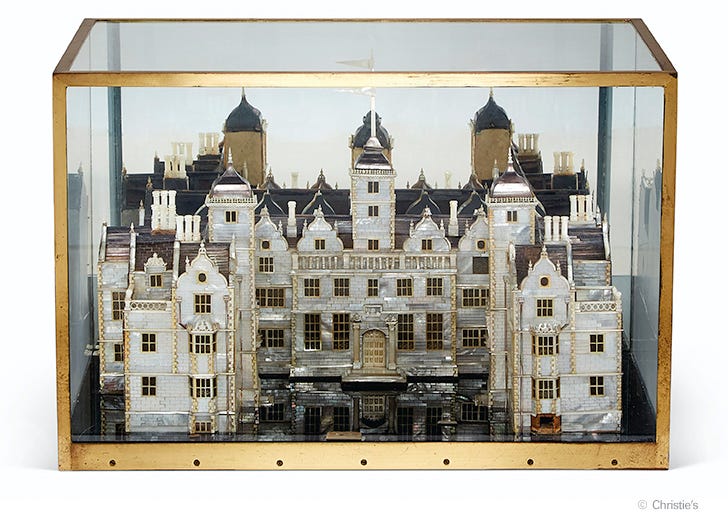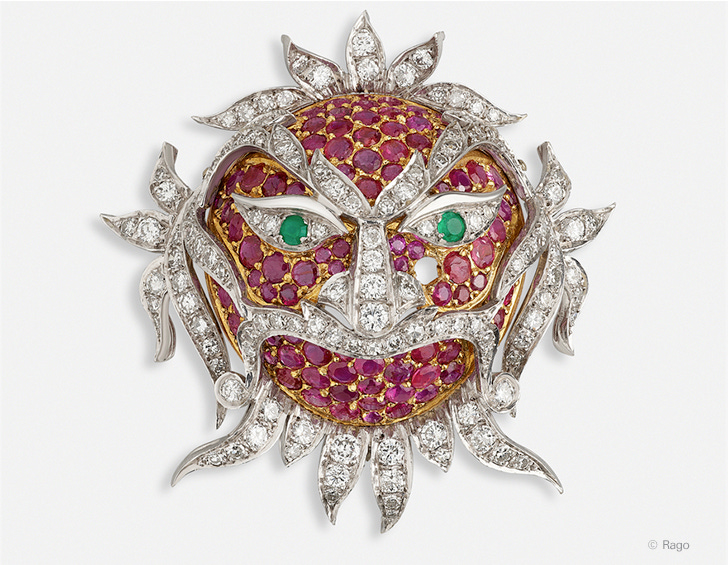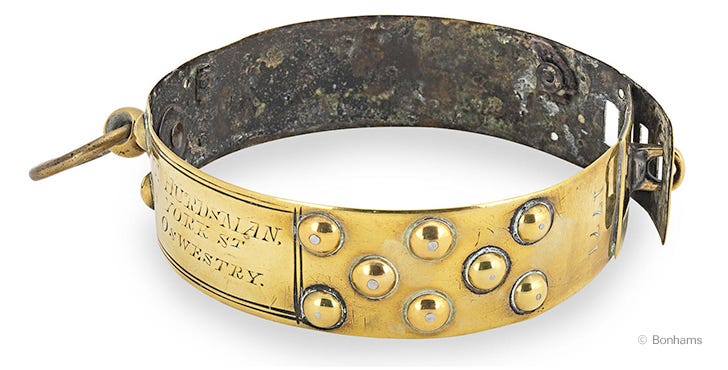A wisteria collar, a haunted Hall, and the life of Silver Sam, Colonial counterfeiter
Also, a small murderous fantasy.
On January 7, the Virginia Museum of Fine Arts (VMFA) announced their recent acquisition of the spectacular Art Nouveau “Wisteria ‘Glycines’” choker designed by Belgian jeweler Philippe Wolfers (1858–1929).
Wolfers was renowned for using carved gemstones in his jewelry, and this piece is a magnificent example. The five swags of wisteria are separated by panels of purple and green plique-à-jour (transparent/translucent enamel with no back, so it looks like stained glass) leaves that are entwined with garnet scrolls and ruby highlights. The wisteria blossoms themselves are created from alternating groups of gemstones. At first glance, that central floral swag resembles enamel — but look closer and you’ll see it’s actually carved watermelon tourmaline, with each stone carefully cut and arranged to make the most of its naturally variegated pink and green hues. The lighter swags consist of pastel-colored, translucent carved opals.
Designed between 1900-1901 and made before January 1902, the back of the choker is marked with Wolfers’ initials and “Ex: Unique,” which means “Exemplaire Unique” or “Unique Example.” The mark was used to differentiate the one-off pieces from the more commercial jewelry created for the Wolfers family company, and this choker is one of only 131 unique pieces designed by Philippe. Many of his others were lost or later dismantled after they’d been used as promotional pieces, but thankfully Wolfers’ wife, Sophie Willstädter, had a sizeable fortune of her own and purchased some of her husband’s best pieces (including this one) in order to keep them in the family.
The choker is already on display in the VMFA’s French Art Nouveau Gallery, and if you have a chance to visit once all this misery is over, please do. The VMFA is one of my top five favorite museums — I traveled down there a few years back for a Fabergé symposium and literally never wanted to leave. Not only do they have the largest public collection of Fabergé outside of Russia, they also have the finest collection of Art Nouveau outside of Paris. (Remember the Sarah Bernhardt sphinx inkwell? They have one, and they also have one of my favorite pieces of Lalique, the Autumn Leaves Diadem.) Not to mention loads of English silver, a great selection of Abstract Expressionist art and a really interesting collection of British sporting art. It’s a very unique conglomeration of stuff, and fantastic place to lose yourself in.
This late 19th century model depicts Birmingham, England’s Aston Hall entirely in mother-of-pearl. Set in a mirrored-back case, the piece is 14 ½” high, 22” wide and 14” deep. It will be included in the Christie’s New York “Collection of Mr. & Mrs. John H. Gutfreund 834 Fifth Avenue” live auction on January 26.
Aston Hall was built for Sir Thomas Holte between 1618 and 1635, and, according to Christie’s, it is “one of the finest examples of Jacobean architecture in England and one of the last great prodigy houses to be erected.” The Hall is now a community museum managed by the Birmingham Museums Trust, and in 2019 was named the UK’s most haunted heritage site by paranormal researchers Spectrum Paranormal Investigations. Apparently Sir Thomas had anger issues, and some of his alleged greatest hits included murdering his cook, driving a houseboy to suicide and locking his daughter in a room for 16 years because she wanted to marry a commoner.
This elegant ca. 1755-60 American silver coffee pot (with a leaf-embellished spout and a handle topped with a shell) is currently up for sale in the Sotheby’s New York “Important Americana: Silver, Chinese Export, and Prints” online auction ending January 22. It was made by Samuel Casey, an American silversmith with a very interesting backstory.
Casey (aka “Silver Sam”) was born in Rhode Island in 1723 or 1724, and at some point he made his way to Massachusetts and an apprenticeship with premiere Boston silversmith Jacob Hurd. In 1750, he moved to South Kingstown, RI, and embarked on a successful career as a merchant and silversmith — Christie’s describes him as “the finest silversmith of his day working outside a major urban center” — until 1764, when he accidentally stoked a fire so hot in his foundry that it set one of the beams behind the chimney alight, burning down his entire home and shop and leaving him destitute.
The next few years saw him dragged in and out of court for failing to pay his debts, until 1770, when he and his brother Gideon (more about him later!) were imprisoned for making and passing counterfeit dollars. Samuel was brought up on felony charges, and the October 19, 1770 issue of The New-London Gazette described the events of his trial:
The Trial lasted till 8 o'Clock in the Evening, when the Jury went out, who did not agree till near 4 in the Morning. They brought in their Verdict Not Guilty: Upon which they Court told them that their Verdict was so contrary to Law and Evidence that it could not be accepted, and they were sent out again; and between Two and Three o'Clock in the Afternoon returned a special Verdict, which was accepted by the Court.
Samuel was found guilty and sentenced to death by hanging. He appealed, but around this time some counterfeiting dies and tools were found hidden away on his property, and his goose was thoroughly cooked.
All of these events were feverishly documented in the press, and there was a lot of public sympathy for Samuel owing to the loss of his livelihood six years earlier. Not long after his sentencing, the Essex Gazette of November 13-20, 1770 reported that:
Saturday last a considerable Number of People riotously assembled in King's County, and which their Faces black'd proceeded to his Majesty's Goal there, the outer Door of which they broke open with Iron Bars and Pick-Axes; they then violently entered the Goal, broke every Lock therein, and set at Liberty sundry Criminals, viz. William Reynolds, Thomas Clarke, Elisha Reynolds, and Samuel Casey, lately convicted of Money-making, one of whom (Samuel Casey) was under Sentence of Death.
Samuel was somehow miraculously (lol) provided with a horse during the jailbreak, and, not being stupid, he blew town and was never heard from again. Many sources end his tale there, speculating that he may have died in New York around 1773 when his wife Martha sold his land, but other sources claim that on September 17th, 1779, she actually begged the RI State General Assembly for a pardon of her husband. The Heritage Foundation Collection of Silver (1968) by Henry Flynt and Martha Gandy Fales quotes Martha as stating that Samuel had “wandered in exile nine years forlorn and forsaken and destitute of every means of support to make his life even desirable, separated from his wife and offspring.”
He got the pardon. We don’t know for sure if any of this is true, but he and Martha had married sometime around 1753 and had four kids, and one of them, Willet, has a Wikipedia entry that claims his father died in the Revolutionary War. So who knows?
And oh yeah, GIDEON. Gideon was Samuel’s younger brother and apparently a talented silversmith himself, and he had actually partnered with Samuel for a decade. But the dude was a serious counterfeiter, and it’s very possible (probable) that Samuel was also in on it — although maybe just as a sideline until the fire? Again, who knows.
Gideon was first arrested in Philadelphia in 1752 for passing counterfeit doubloons, and from then on, according to an article in the April 1953 issue of Rhode Island History, he bounced all over New York and New England as part of “a band of counterfeiters, numbering at least five hundred, who corresponded through all the colonies as far as North Carolina.”
Gideon was even caught red-handed — on a boat, with all his stuff! — in New York in 1768 but was still somehow acquitted for insufficient evidence. He also might NOT have been arrested with Samuel in 1770 — not all the sources agree on that — but basically from that point on he went to ground and may have assumed another identity. Did he help break his brother out of jail? I have no idea, but I would certainly hope so.
And people* think silver is boring!
*my former boss, a Furniture Guy who always dumped all the silver on me to catalog
Circa 1880, this sunburst tiara centers two haloes of turquoise cabochons amid 5.80 carats of old mine cut diamonds set in gold and silver. The sunburst is detachable and can be worn as a brooch, and the silver headband is a later addition. Every time I see one of these I daydrea*COUGH* think dispassionately about how one could possibly dip the tips in poison for use as a murder weapon.
Circa 1810, this French brooch places a diamond-laden motto over a field of blue guilloché enamel that — on second, closer look — reveals an eye peering out from below. The rose-cut diamond motto states: “Je ne vois que toi,” or “I only see you.” The brooch is finished with a border of flat- and old-cut diamonds set in 18k and silver.
It’s wonderfully striking, and I haven’t seen anything like it before. The “lover’s eye” jewelry trend (which I talked about back in the day for the Hairpin; scroll down to the last item) was still going on in 1810, but while it shares a similar sentiment, this piece is in a different style universe compared with the fragile watercolor delicacy of a typical lover’s eye miniature, and may have been a custom piece.
This early/mid Victorian signet ring features a bloodstone intaglio that depicts a ship and castle battlements, with a flag flying the name “Montevideo.” Between 1843 and 1851, the city of Montevideo was under heavy siege during the Uruguayan Civil War. The British and French pitched in to lend the city their sea power, so this ring may commemorate that event.
Hidden beneath the ring is a key that would open a document or jewelry box. It’s hinged, so it can be flipped up and used when needed.
In Japanese folklore, an Oni is an evil demon that roams the spirit world, bringing disaster to any unfortunate being they meet. Although they’re basically spirits that are invisible to the human eye, they’re usually depicted with unsettling physical characteristics like horns, sharp teeth and crazy hair, and masks featuring Oni characters are often used in Japanese theater and festivals. More recently, however, culture has evolved to allow for less ferocious interpretations of Oni, and some are now viewed as protective spirits who help ward off bad luck.
This 18k yellow and white gold pin is designed as an Oni face mask set with single and round brilliant-cut diamonds, circular-cut rubies (one missing!) and emerald eyes. It’s in the Rago “Jewels XOXO” auction on February 3, but to be honest, I’m really including it because it looks bizarrely like something my friend Edith Zimmerman would draw — I think it’s something about the eyes? And that missing ruby is totally her kind of detail. Edith currently draws/writes a lovely, thoughtful and occasionally surreal newsletter called Drawing Links, and I highly recommend subscribing (if you haven’t already).
The Bonhams “The Oak Interior” auction in Oxford on January 20 features a few different brass dog collars, including this one, a George III collar with dome-topped brass studs, a brass ring and an adjustable clasp. It’s engraved with the year “1771” and “T. HURDSMAN / YORK ST / OSWESTRY.”
I’m not sure why, but there’s a pair of suede and leather lederhosen in the Skinner “Discovery - Jewelry & Silver” online auction ending on January 25. Estimate $20-200. Just, you know, fyi.
Welp, that’s it for today. I hope you’re all safe and well and treating yourselves kindly. As always, feel free to leave a comment, reply to this email, or find me on Twitter at @rococopacetic. Have a good week! xxx
Thanks for reading, and if you haven’t already subscribed, sign up here:













Such an exciting history lesson! The VMFA has been added to my “must see” list. One of these days... Thanks, Monica!
Yes, Claire is right - that was my favorite part too. Please continue to share your murderous fantasies with us Monica!